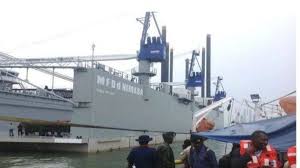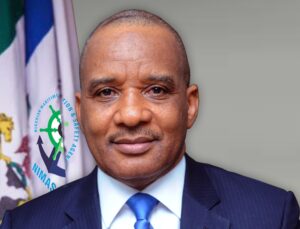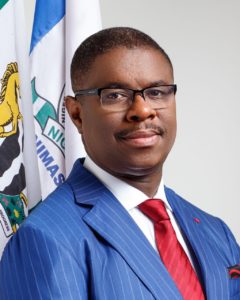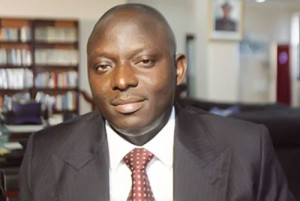It has been said that government has no business doing business. Could this saying be true of the Floating Dock acquired by the Nigerian Maritime Administration and Safety Agency (NIMASA) in 2018 that is yet to be put to use ever since then? Otherwise, how could an asset worth N50 billion naira be left to rot away in an unexplainable circumstances? Yet, the asset is believed to rake in N1 billion monthly and N12 billion annually if properly deployed. This knowledge notwithstanding, the asset was abandoned to idle away even as it still fritter away fund for doing nothing.
While awaiting the arrival of the floating dock to Nigeria, the immediate past Director General of NIMASA, Dr. Dakuku Peterside said that the aim of acquiring a floating dock was to save the country from the capital flights as a result of dry docking vessels outside the country.
Going further, Peterside said, “Availability of the floating docks will save us capital flight because right now, most Nigerian vessels are dry-docked outside the country. The issue of dry docking vessels outside the country and loss of foreign exchange will soon be a thing of the past.”
On arrival of the facility to Nigeria, the newly acquired floating dock failed to berth one week after arriving the country due to the inability of the regulatory agency to make necessary arrangement for its berthing. Investigations revealed that no arrangement was made for the vessel’s berthing until it arrived Lagos water on June 11, 2018.
The then Head of Communications, NIMASA, Mr. Isichei Osamgbi was quoted as saying that despite various communications from the builders of the floating dock, NIRDA in Amsterdam, Netherlands, no arrangement was made for the berthing of the vessel which according to him was a big shame.
It was reported that when the floating dock arrived, everyone including the then Director General, Dakuku Peterside started running helter-skelter to find a berth for the dock. Report had it that various terminal operators demanded various sums of money ranging from $350,000 to $52,000 per day to berth the floating dock but NIMASA was not ready to part with such amount. The Director General, Peterside Dakuku, also approached the Nigerian Ports Authority then but met a brick wall, however, Niger Dock agreed to accept the floating dock for $26,000 per day with some other conditions.
The then Director General of the Agency, Dr. Dakuku Peterside had earlier told journalists during an interactive session with them in Lagos in August 2018 that the multimillion dollar floating dockyard owned by NIMASA which arrived the country in June of same year would save the country millions of dollars in capital flight once operational noting that efforts were being made to create enabling environment for the growth of indigenous participation in shipping.
Dakuku said during the session that the facility which would be operated on a Public Private Partnership (PPP) model will be located at a facility of the Nigerian Navy.
The NIMASA DG said that the Floating Dockyard would commence operations immediately after the commissioning by President Muhammadu Buhari. He added that when fully operational, Nigerian Shipowners and their foreign counterparts would no longer need to take their vessels outside the country for dry docking.
According to him, “Nigeria loses up to $100m annually simply because when our shipowners need to dry dock their vessels, they mostly take them to neighboring countries like Ghana and Cameroun thus spending avoidable FOREX. When this facility is fully operational, it has the capacity to dry-dock any vessel in-country and save the much needed foreign exchange”.
Speaking further, Dr. Peterside noted that the facility would be operated in conjunction with the builders as technical partners. He also assured that it will create thousands of jobs for teeming Nigerian youths as well as provide training opportunities for seafarers, adding that the NIMASA floating dockyard would also be available as a training facility for the students of the Nigerian Maritime University, Okerenkoko and other maritime institutions in the country.
“We are planning to ensure that the permanent location of this facility would benefit our students for training and we have also engaged the builders to manage the facility for a one year period at a Naval facility while further arrangements are being worked out”, he said.
Not long after the floating dock was finally berthed had the Pan Niger Delta Forum (PANDEF) warned the Nigerian Maritime Administration and Safety Agency (NIMASA) to rescind its plan to divert the floating dock that was to be situated at Okerenkoko, Delta State. The warning was contained in a communiqué issued at the end of an expanded National Executive Committee Meeting of the Forum held at Benin City, Edo State.
The original conception and design of the floating dock as approved by the former NIMASA Management led by the then Director-General, Patrick Akpobolokemi, shows that it was meant to be taken to Maritime University, Okerenkoko, Delta state, in the belief that it would help boost the country’s ship repair capacity, generate wealth and create employment for Nigerians. It was also targeted to serve as a training facility for the students of the Nigerian Maritime University, Okerenkoko and other maritime institutions in the country.
However, the then NIMASA’s Executive Director, Operations, Rotimi Fashakin, had said that insecurity in the Niger Delta region made it difficult for the agency to berth the dock at Okerenkoko as originally designed, keeping the facility idle at the Naval dockyard, pending when the agency would get a permanent location to operate it.
However, speaking in January last year on why the floating dock is yet to be put to use, Dakuku Peterside blamed the delay in deploying the asset almost two years after its arrival to the country on the inability of NIMASA to secure an operational berthing space for the dock.
According to the then Director-General, Peterside, the floating dock has not commenced operation due to multifaceted challenges ranging from lack of appropriate and suitable location to insecurity in the Delta region where it was originally meant to be located. Dakuku said the floating dock could not be put to use at its present location because of security issues since operation of a floating dock facility could not be carried out within the Naval yard.
“Originally, it was designed to berth in Delta State but even at that time, there were lots of reports advising to the contrary. Those reports are still there till date. When we got here, we were forced to review all these reports and make a decision that we think will serve the best interest of the country and the shipping community. That is very foundation of the issue.
“So based on the series of reports, the company that built it and another company that we engaged believed that there are grey issues that needed to be sorted out. We all agreed that based on the advice of all the experts, what make sense is to locate it in Lagos until such a time a final decision will be reached on it. In Lagos, we are following due process on the operating berthing place. What we have now is a storage berthing place. We believe that will conclude very soon before the end of the year and we will commence operation at the operating location.”
Tweeting via @jacksonpbn more than one year after the arrival of the floating dock to Nigeria, Global Peace Ambassador and Strategic Communication expert, Jackson Ude disclosed that “The recently acquired floating dock by NIMASA for which $30k is being paid daily, has been abandoned since it was acquired in 2018.
“A leaked document last month showed a controversial award of a contract worth N248,850,000 (Two hundred and Forty-Eight Million, Eight Hundred and Fifty Thousand Naira) to one Thames Hudson Consulting and Contracting Limited for the dry docking and repair of one of NIMASA boats, MV Ofure.
“Thames Hudson Consulting and Contracting Limited, a brokerage company, is not known to own any ship repair facility either in or outside Nigeria, according to its website.”
Meanwhile, on assumption of office on March 10, 2020, the Director General of NIMASA, Dr. Bashir Jamoh did not show any commitment to the revitalization of the floating dock two years after its acquisition. But aware of the economic importance of the facility, Jamoh during a media meeting with journalists to mark his 100 days in office said that the asset will be generating N1 billion monthly and N12 billion annually by the time it starts operation.
He however continued with the story his predecessor told by saying that NIMASA was partnering with the Nigerian Ports Authority (NPA) to get a permanent place for the platform, which would enable several vessels to dry-dock in the country. This he said without recourse to the $30,000 cost the facility incurs daily.
Jamoh asserted, “Presently, the floating dock is at the Naval Dockyard and we are making everything possible to get it to the Continental Shipyard when the Nigerian Ports Authority would have wound down its operation at the yard.”
Going forward, industry stakeholders recently called on NIMASA to partner the Nigerian Ports Authority (NPA) in order to effectively utilize its newly-acquired floating dock. The stakeholders said that it was needful for NIMASA to take a decision on putting the floating dock to use immediately than allowing the about N50 billion facility lay wasted at the Marina. The stakeholders further said that partnering with the NPA would be the best option as it already had capacity for operations of the floating dock at the Continental ship yard.
They noted that the NPA floating dock at the Continental ship yard had not been operational for a long time due to technical issues, therefore making room for a new one to replace it if and when an agreement could be considered.
Just on Tuesday this week, the Association of Marine Engineers and Surveyors (AMES) raised the alarm that the N50bn Floating Dock acquired by NIMASA in 2018 is becoming derelict adding that it has been removed from the Lloyd’s Registers Class as it has not been surveyed for the past three years.
The President of AMES, Engineer Yinka Okunade, in a press briefing in Lagos stated that the attention of the association had been drawn to the non-utilization of the Floating Dry-dock that was delivered in 2018 to NIMASA which is now laid up and wasting away at the Naval Dockyard in Lagos.
Okunade explained that the Floating Dry-dock is of Modular type constructed by DAMEN SHIPYARDS GORINCHEM of Netherlands in 2016.
He urged the federal government through the Minister of Transportation to urgently direct NIMASA to either immediately put the facility into operation or hand it over to a marine engineering organization that specializes in ship dry-dock and repairs.
“The Floating Dry-dock which was built to Lloyds Register’s Class has not been surveyed since its delivery to Nigeria over three years ago. The Class has been withdrawn and the floating dock is now seriously becoming a derelict.
“A Floating Dry-dock is one of five types of dry-docks used for ship repairs. It is a submersible platform that is specifically designed and used to repair vessels. It is a mobile facility that can be navigated to the location of a disabled vessel at sea, carry the vessel and navigate back to base where the disabled vessel can then be repaired and restored back to service.
“The Association of Marine Engineers & Surveyors (AMES) believes that the acquisition of a Floating Dry-dock was a sound decision by NIMASA, based on the drive to develop the maritime industry infrastructure. In fact, the acquisition and eventual operation of the Dock would solve the perennial dilemma faced by indigenous ship owners and ship operators in complying with the statutory requirement to dry-dock their vessels. In addition, this will generate employment in the maritime Industry.
“However, our findings have confirmed that the floating dock (MFDP NIMASA) is presently moored at the Naval Dockyard, in Commodore Pool, located at Victoria Island, Lagos. The Dock is now three years at this location and rusting away, as a result of the treacherous sea-like weather conditions at the Naval Dockyard berth.
“According to our findings, the Floating Dry-dock cost about N50 Billion to acquire; over N3.6 Million in daily expenses, and US$30,000 per day as berthing charges to the Nigerian Navy. Why would NIMASA choose the Naval Dockyard and not the Nigerian Ports Authority (NPA), a sister agency which already has a dedicated berth for a Floating Dry-dock? In the opinion of AMES, the mooring of the floating dock (MFDP NIMASA) at the Naval Dockyard is an avoidable wastage in terms of not only humongous expenses but the safety of the Floating Dry-dock itself and the potential environmental pollution that may occur.
“Having been constructed in 2016 by DAMEN SHIPYARD, the MFDP NIMASA is now already due for its Renewal Class Survey, which has not been carried out, and as a result, the dock has been withdrawn from Class. By implication, therefore, the dock could not have been insured. Imagine an asset of N50 Billion without insurance?
“AMES hereby wishes to draw the attention of the federal government to the foregoing and to request an urgent directive to the federal Minister of Transportation to do the following: Order NIMASA and NPA which are maritime agencies of the same ministry to synergize and commission the MFDP NIMASA into operation immediately. NPA already has a fit-for-purpose berth and back-up yard with workshop facilities at Apapa which is lying waste. NIMASA having already procured the Floating Dry-dock should take advantage of this already existing berth facility of NPA to put the MFDP NIMASA to immediate use.
“Furthermore, the Floating Dry-dock should be handed over to a Marine Engineering company that specializes in Ship Repairs and Maintenance to operate it.”
And one would be forced to ask, has NIMASA been able to save the country from the capital flights arising from dry docking outside the country since the arrival of the floating dock? Has the floating dock fulfilled its purpose to Nigerians? I leave you to answer the questions yourselves judging from the scenario painted above.
Photo 1: NIMASA Floating Dry-dock.
Photo 2: The Director General, NIMASA, Dr. Bashir Jamoh.
Photo 3: Former Director General, NIMASA, Dr. Dakuku Peterside.
Photo 4: Former Director General, NIMASA, Dr. Patrick Akpobolokemi.
Send your news, press releases/articles to augustinenwadinamuo@yahoo.com. Also, follow us on Twitter @ptreporters and on Facebook on facebook.com/primetimereporters or call the editor on 07030661526, 08053908817.





1 Comment
It is a shame we waste such monies in this country